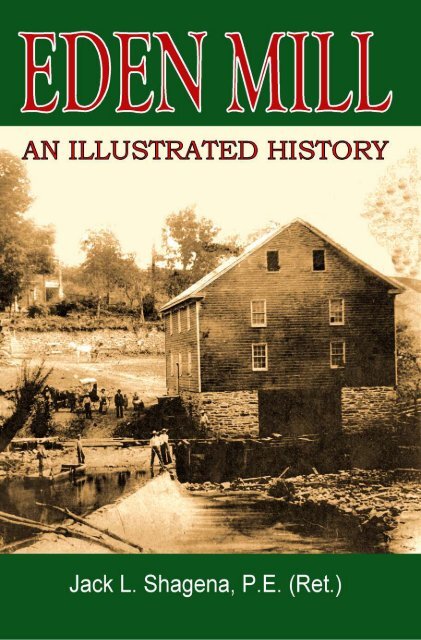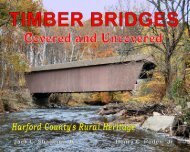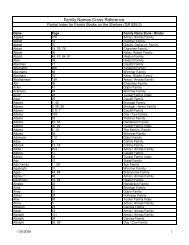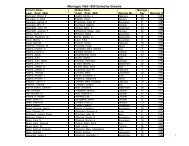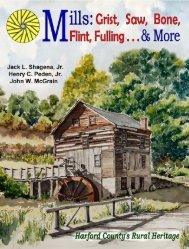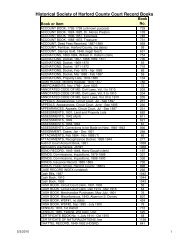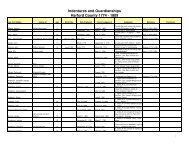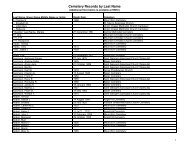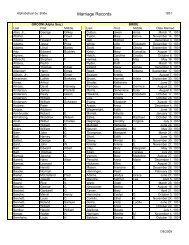Untitled - THE HISTORICAL SOCIETY OF HARFORD COUNTY ...
Untitled - THE HISTORICAL SOCIETY OF HARFORD COUNTY ...
Untitled - THE HISTORICAL SOCIETY OF HARFORD COUNTY ...
Create successful ePaper yourself
Turn your PDF publications into a flip-book with our unique Google optimized e-Paper software.
Table of Contents<br />
Chapter 1 – Early History of Harford County 9<br />
Smith Discovers the Susquehanna 10<br />
Mingo Indians 14<br />
Iroquois Confederation 17<br />
Eden Hundred 18<br />
The Name “Eden Mill” 21<br />
Chapter 2 – The Stansbury Family in Maryland 25<br />
Tobias Starnborough (c.1652-1709) 25<br />
Daniel Stansbury (1678-1763) 26<br />
William Stansbury (1716-1788) 27<br />
Elijah Stansbury (c.1755-1837) 28<br />
Elijah Stansbury, Jr. (1791-1883) 32<br />
James E. Stansbury 32<br />
Chapter 3 – The Stansbury Mansion 35<br />
Bricks 35<br />
Building the Mansion 37<br />
External Architecture 39<br />
Interior Layout 41<br />
Ground Level 41<br />
Stairway 43<br />
Second Level 44<br />
Third Level 45<br />
Out Buildings and Structures 45<br />
Privy 45<br />
Barn 47<br />
Icehouse 50<br />
Smokehouse 51<br />
Upping Stone 52<br />
Graveyard 53
Chapter 4 – A Century of Grist Milling 57<br />
Elijah Stansbury’s Milldam 58<br />
Sawmill 60<br />
Gristmill Waterwheel 63<br />
Gristmill Design 64<br />
Farming the Land 66<br />
Fulling Mill 66<br />
John E. Stansbury (mill owner 1883-1841) 68<br />
Isaac Stansbury (mill owner 1841-1861) 68<br />
James Stansbury (mill owner 1861-1879) 69<br />
John E. Stansbury (mill owner 1879-1883) 70<br />
George L. Anderson (mill owner 1883-1896) 70<br />
Chapter 5 – Roller Milling on Deer Creek 73<br />
Stansbury’s Gristmill 74<br />
George L. Anderson (mill owner 1883-1896) 76<br />
John T. Anderson (mill owner 1897-1900) 80<br />
Howard S. Jefferson (mill owner 1900-1901) 81<br />
John Marsteller and Asa J. Van Sant (1901-c.1905) 81<br />
John Marsteller and J. Frank Wolfe (c.1905-1912) 85<br />
Marshall, Harry, and Oscar Stokes (1913-1914) 86<br />
M. Marshall Stokes (1914-1914) 86<br />
J. Smith, A. Morris and W. Manifold (1917-1919) 86<br />
Chapter 6 – Lighting the Way 89<br />
Lamps 90<br />
Candles Fuels 91<br />
Making the Candles 92<br />
Candlesticks & Lanthorns 93<br />
Coal Oil 95<br />
Electric Lighting 95<br />
Fawn Light and Power Company 96<br />
The Generating Equipment 99<br />
2
Chapter 7 – End of an Era 103<br />
New Storage Buildings 108<br />
Milling 109<br />
Millers 113<br />
Harvesting Ice 115<br />
Nature Habitat 117<br />
Chapter 8 – A New Beginning 119<br />
Timing Is Everything 119<br />
Enter Donald “Spike” Webb 120<br />
Eden Mill Foundation 121<br />
Controversial Picnic 122<br />
County Funding Found 122<br />
Dam Problem 123<br />
Eden Mill Ambles Along and Stumbles 123<br />
Frank Marsden – A Man With A Plan 126<br />
A Group Gets Going 128<br />
Peggy Eppig 128<br />
Sylvia Hutt 129<br />
Dick and Elaine Knight 130<br />
Jerry Logan 131<br />
Sharon and John Miller 132<br />
Andrea Musser 132<br />
Setting Goals for the Nature Center 133<br />
The Years Ahead 134<br />
Nature Center 134<br />
Mill Museum 135<br />
A Synergistic Organization 137<br />
Appendix A – Eden Mill Owners 139<br />
Appendix B – Eden Milling Company Product Bags 143<br />
Appendix C – Memories of a Miller’s Family 149<br />
Index 155<br />
3
Preface<br />
It was principally water that powered the development of<br />
industry in early America. Harford County, with its eastern portion<br />
adjacent to the coastal plain and the terrain rising towards the West,<br />
was a geographically ideal location. The fall of water along the Bush<br />
River, Winters Run, Bynum Run, Little Gunpowder Falls, and Deer<br />
Creek provided about one hundred locations for entrepreneurs to<br />
build and operate mills.<br />
Josiah Carter was the first to acquire a waterpower site in the<br />
northwestern part of the county along Deer Creek called “The<br />
Miller’s Fancy.” In 1792, he transferred his land and water rights to<br />
Isaac Stansbury whose brother Elijah built a milldam, constructed a<br />
gristmill and sawmill, and established a farm. Although the Stansbury<br />
family had deep roots in Baltimore County going back to 1658, Elijah<br />
was the first to enter the milling business, which was continued by his<br />
descendents for eighty-five years. His legacy remains in the beautiful<br />
brick mansion that still towers over the site.<br />
Stone grist milling introduced by Elijah became obsolete in<br />
the late nineteenth century, and with a change in technology, new<br />
owners emerged to carry on the milling business. In the decades<br />
following the Civil War, however, flour prices fell and with their<br />
decline so did the profits, as a series of entrepreneurs struggled<br />
financially to keep the mill operating.<br />
Help came in 1919 when electrical generators went online to<br />
power lights and machinery in nearby Fawn Grove, Pennsylvania.<br />
This, unfortunately, was short lived, as less than a decade later<br />
maturing of the power industry eliminated the need for the<br />
hydroelectric source. Sustaining its traditional roots, the mill<br />
continued to grind grain for the local community until1964.<br />
In 1965 Harford County Department of Parks and Recreation<br />
acquired the mill and fifty-seven and one-half acres of land. Through<br />
the committed and dedicated support of a volunteer-led non-profit<br />
organization, the park has been revitalized, and today serves<br />
thousands of nature-seeking visitors each year. The group has<br />
recently begun promoting the Historic Eden Mill Museum to attract<br />
people wanting to learn about industrial grain-milling history.


